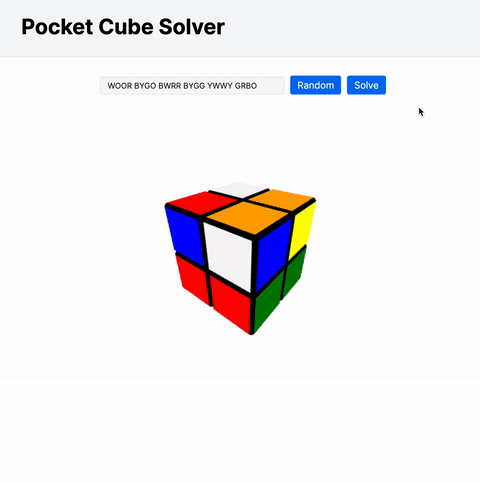Building an optimal Pocket Cube (2x2x2) Solver using Rust/WASM and Three.js/React
Over the past couple of months, I have been very interested in exploring how to efficiently visualise and solve a Rubik’s Cube. Coupled with my desire to experiment with Rust and WASM, this felt like a great opportunity to blend the two. However, before solving a 3x3x3 Rubik’s Cube, I thought it would be beneficial to explore how to optimally solve a Pocket Cube first.
Characteristics of a Pocket Cube
There is plenty of prior art in this space, and thanks to some key characteristics of a 2x2x2 Pocket Cube, optimally solving a given cube state is not too computationally intensive.
The Pocket Cube consists of 8 cubies, each with three coloured stickers on them.
Any permutation of the cubies is possible, with seven of these being able to be independently oriented in three ways.
If we fix one of these cubies to a chosen position and orientation (essentially deeming it to be in a solved state), we can permit any permutation of the remaining seven cubies and any orientation of six cubies.
This results in there only being 7! * 3^6 = 3,674,160 possible unique states.
To ensure that we fix the given ‘solved’ cubie, we are only required to implement three of the possible six moves.
These are Up, Right, and Front in my case - resulting in the Down-Bottom-Left (DBL) cubie staying in place at all times.
By fixing a single cubie, we have managed to reduce the number of valid states.
As such, employing a conventional graph search algorithm over the search space provides us with an efficient means to reach the optimal solution move sequence.
I was able to model this representation of a Pocket Cube in Rust, taking advantage of the ability to inline tests within the same file to provide additional confidence.
Using a Bidirectional Search
As we know the desired goal state and the initial cube state, we can employ two simultaneous breadth-first searches - one going forward from the initial state and one backward from the goal state, stopping when they meet. In doing this, we provide a means to restrict the branching that occurs when the search is being performed into two separate sub-graphs, dramatically reducing the amount of exploration required.
Suppose the branching factor of the tree is
b, and the distance of the goal vertex from the source isd, then the trivial breadth-first search complexity would beO(b^d). On the other hand, if we execute two search operations, then the complexity would beO(b^(d/2))for each search, with a total complexity ofO(b^(d/2) + b^(d/2)), which is far less thanO(b^d).
On top of this, we are able to prune out move sequences that exceed God’s Number, which is eleven moves for a Pocket Cube. I had a lot of fun implementing this algorithm in Rust and, in turn, exposing the solver to the browser/JavaScript using WASM.
Visualising the Solution
Now that I was able to optimally solve a given cube state in the browser via WASM, the next step was to provide a pleasing visualisation that could be followed along using a real Pocket Cube. For this, I decided to build the client in React using Three.js, react-three-fiber, and TypeScript. I have had little experience with Three.js until now but thought it would be interesting to explore constructing such models in a declarative manner using React.
I found this to be a very rewarding experience, using a facelet representation of the cube state to communicate between the client and the solver. The cube component itself took advantage of React Hooks to manage the state transitions and rotation animations.
Conclusion
To conclude, I learned a great deal about the Pocket/Rubik Cube solution space, coupled with Rust and Three.js, while completing this project. The actual solver algorithm itself, being relatively simple, allowed me to concentrate my efforts on learning Rust and its interoperability with WebAssembly. Going forward, I wish to expand upon this project and build a solver for the 3x3x3 Rubik’s Cube.

